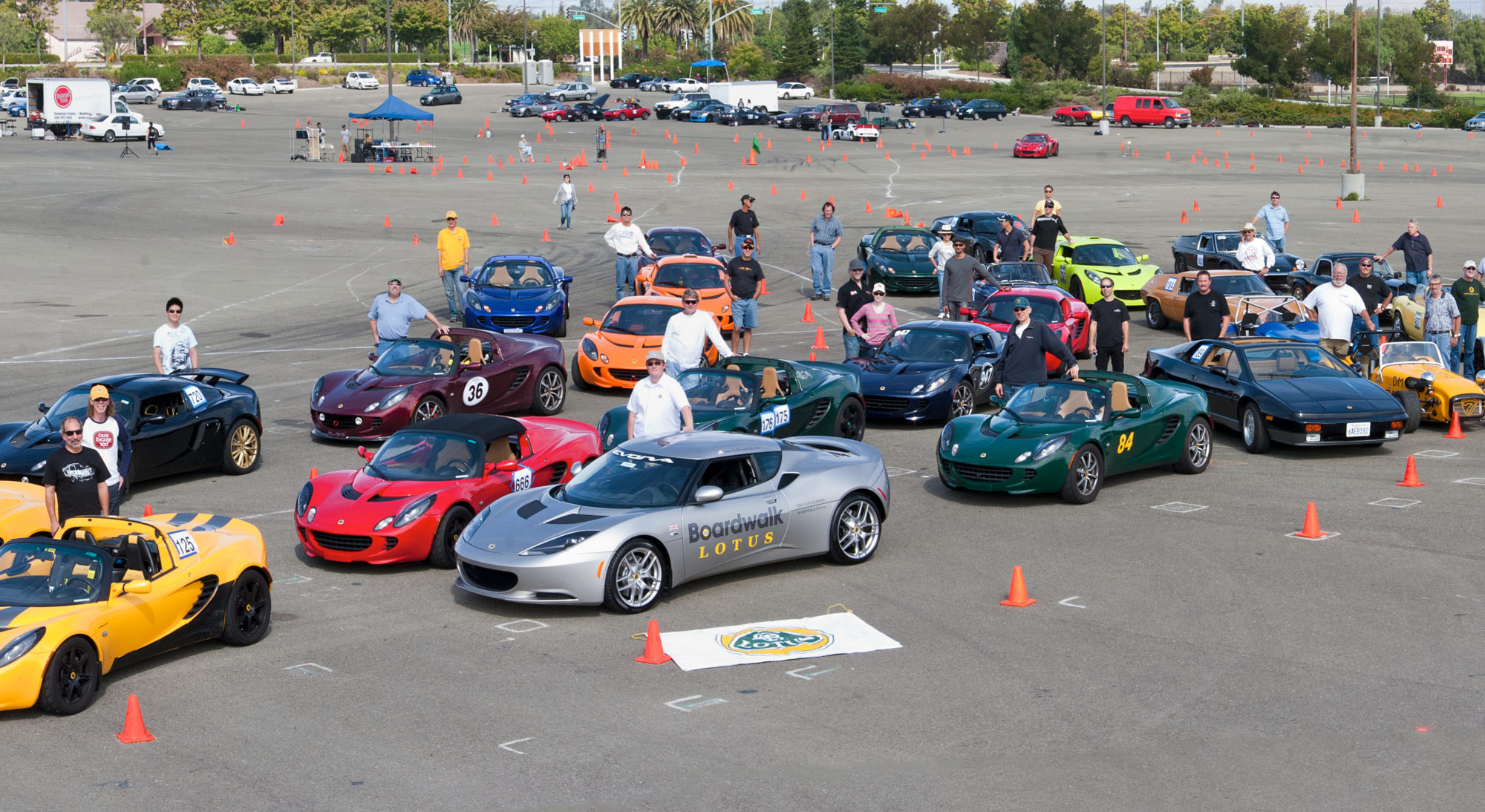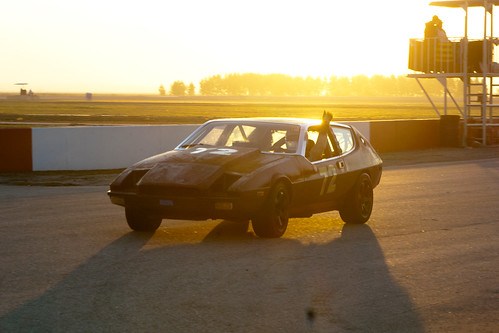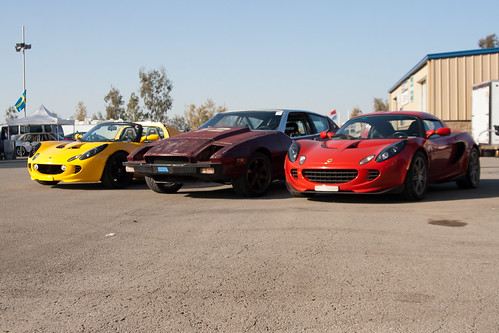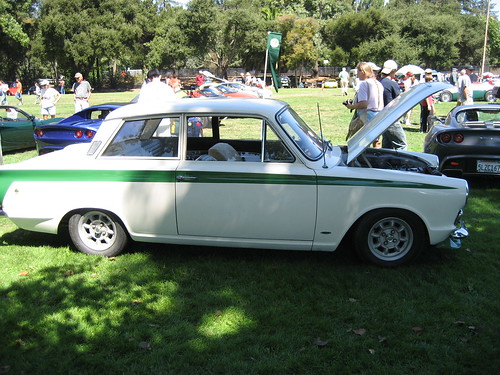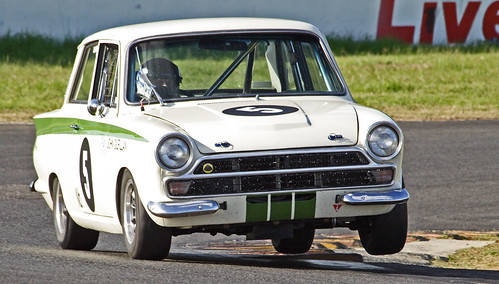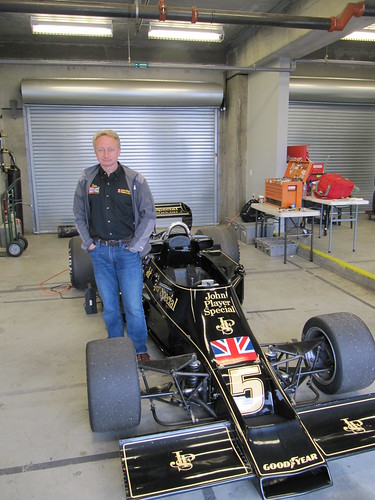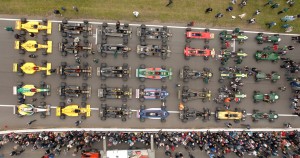Duncan Dayton pushing his priceless Lotus 79 to the limit at the 2015 Monterey Motorsports Reunion at Laguna Seca
The Road to Elite Enlightenment
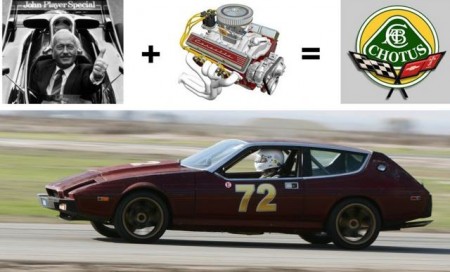
On December 4th 2011, a 1974 Lotus Elite with a Chevy V8 engine competed in a 15 hour endurance event at Buttonwillow, California.
It didn’t do very well.
This is the story of our path. You can follow it if you like. Probably best if you don’t though.
Step 1. Buy a Lotus Elite.
Possibly the hardest part of the operation, as there are likely less than 100 of these fantastic machines in working order in the US. We found our car by advertising a second hand fridge on Craigslist, then asking the guys who showed up they have a Lotus Elite they’d like to swap for the fridge. We asked him to throw in a couple of hundred bucks.
Step 2. Bring the Elite home.
We found out that Colin, being his usual efficient self, used the drive shafts as the upper suspension elements. With the diff in the standard place for the Elite (the trunk), towing quickly resulted in two flat tires as they impinged on the incredibly sharp shock tower brackets.
Step 3. Look for the rear brakes.
We found them in the trunk. With the diff. On the diff actually. And they’re drums.
Step 4. Remove the Interior.
Everyone knows that to be competitive in a race you should make your car as light as possible by removing the creature comforts such as passenger seats and the air conditioning. The Elite was originally a luxury 2+2 as it rolled off the production line all those years ago, but Colin was alive at the time, and simplify and add lightness was still the rule in Hethel. Removing all the interior saved us about 10 pounds, but vastly reduced the amount of tan corduroy we see on a daily basis.
Step 5. Build a cage.
In fact, we didn’t build a cage. It’s far too difficult for a Joe Shmoe like you and me. We took it to an expert cage builder who scratched his head at the challenge of finding enough metal in the car to weld to. In the end he built a complete under floor chassis to hold the seat to the cage. In the event of a really big hit the fiberglass body may part company with the cage, but at least we’ll still be in the cage.

Step 6. Install the diff.
We set aside about 3 days for this task, not really because the diff is hard to install, but that with the drums on the diff you have to connect brake lines to the diff when the diff is in place. We could have saved about 2.5 of those days if had cut large holes in the fiberglass by the transmission tunnel to access the brake lines from the back seat. We did this after spending the 3 days installing the diff.
Step 7. Get the Chevy V8 running.
This is ridiculously easy provided you don’t have the distributor set 180 degrees out. You’ll know if you’ve done this because 8 foot flames out of the carburetor are not normal. Neither is blowing the breather out of the valve cover into your overhead florescent lights.
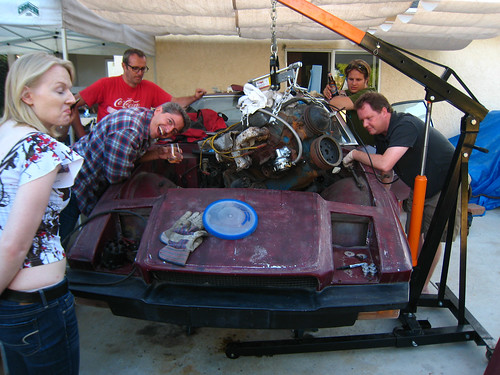
Step 8. Go to the practice day on the Friday before the race.
A novice would think that the practice day is to tune up the performance of the car on track. It turns out that normal procedure is to hammer on the radiator fan shroud to try and reduce interference. Take the radiator out to have to hole you just made in it repaired. Bleed the brakes 9 times. Go out on track for ¼ of a lap and get towed in with an apparent fuel problem. Wonder what’s causing the blue smoke to come out of the exhaust but not have time to investigate it. Fail tech by putting the battery in the trunk, so that with a big rear end hit we have a heavy object to puncture the gas tank and a spark source to ignite it. Move the battery to the rear seat, and collapse in a heap from a 14 hour day working on the car.
Step 9. Line up for the start on Saturday.
Again a novice would think that this is to take part in the race. Instead this is so that we could get towed off after another ¼ of a lap with the fuel problem that we had the day before but didn’t solve. We installed an electric pump instead of the mechanical one and wondered why we still had a fuel problem. We replaced the inline fuel filter and wondered why we still had a fuel problem. We examined the interior of the carburetor and wondered why we still had a fuel problem. We found a kink in the fuel line right under the gas tank and knew why we had a fuel problem.
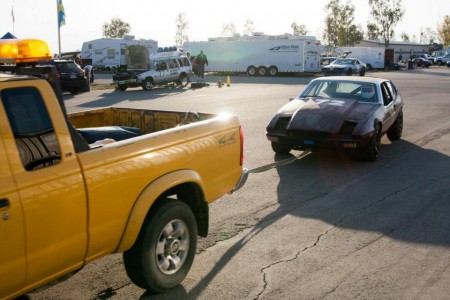
At last we got to run two laps of the track before getting black flagged for leaving blue smoke swath so bad we understood why James Bond liked Lotuses. Back to the pits we started taking the engine apart and wondered if we did anything bad to the internals when we spat flames out of the carburetor. Nah. That couldn’t be it.

Actually…
Backfires (frontfires?) could have blown the intake gasket, letting oil into some of the cylinders. Good job it’s easy to take the intake manifold off a V8 and replace it. While we’re in the pits we drained the ½ gallon of gasoline in the trunk and tried and figure out where it’s coming from. We connected tubes to the breathers that vented into the trunk. Finally! The car was fixed and we could get back out on track. Shame that racing for the day stopped 6 hours ago.
Step 10. Go racing!
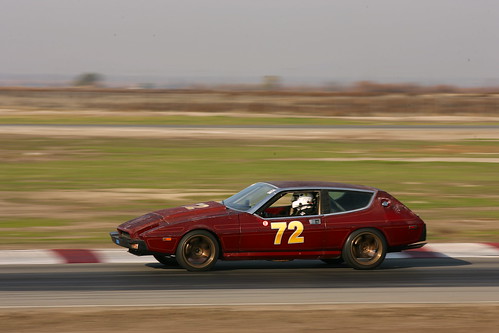
Really! The car was ready and fun to drive! For two laps. Then we needed to change out the rear tires for smaller ones to stop them impinging on the subframe (see Step 2) we went back out but the car just got slower and slower…
The throttle cable was stretching due to a bad pull angle from the accelerator pedal. Another stop and an adjustment on the throttle made the car faster again, but it was a temporary fix as the cable started to fray in the sheath, making it stick.
In the end the Chotus completed 60 laps over 2 days but it did come back from Buttonwillow in better condition than how it went. We can’t wait for Infineon
By Steve Warwick
B-Team Racing
Photos by B-Team Racing and Vanhap Photography
Metamorphosis
Fantastic video shot by Parabolique for Scott Walkers Lotus specialists.
Metamorphosis – Scottwalkers from Parabolique on Vimeo.
Lotus esprit to evora … a test drive on beautiful twisty UK roads
English Ford Reunion @ Laguna Seca (Apr 30 – May 1)
On Saturday April 30th and Sunday May 1st. The SCCA, along with HSR-West, will be holding their only “vintage” race event of the year at Mazda Raceway at Laguna Seca. In addition to some other featured races, we are gathering for a ENGLISH FORD Reunion featuring Anglia’s, Escort’s and the legendary Lotus Cortina.
There will be plenty of track time for all involved. Saturday will have a 15 minute warm up session, a 15 minute timed qualifying session and a 25 minute feature race. Sunday will have a 20 minute warm up and a 25 minute feature later in the day. Our cars will be run in a “small bore” production class with the exception of later model Escorts that have the option to run in “big bore production”. All this on one of the most beautiful and challenging world class facilities around.
The SCCA has asked that all of the English Ford race cars park together in the paddock. Special parking for all street cars will also be available. SCCA is also offering a lap of the track and lunch for $20.00.
On Saturday night, we will feature a special dinner for all of you English Ford and Lotus fans out there. Legendary racer Bob Winkelmann will be one of our special guests, bringing along a ton of old race photos and the stories to back them up. Joining Bob will be former TEAM LOTUS mechanic, Syd Carr. Syd worked on the Team Lotus Cortina race team with Jim Clark, Graham Hill, Jackie Stewart and a host of other hero drivers from the 60’s. Syd also worked on the Formula Two and Formula One race teams. Syd will also be sharing photos and stories. We are in the process of scanning all of these photos will use a LCD system to show them. Both will be open to Q & A during the evening. This is a night not to miss.
The number of those attending will determine the venue. Most likely THE BAJA CANTINA in nearby Carmel Valley. Great mexican food and a new banquet room that seats up to 80. A great place that is very racer friendly.
THE ORGANIZERS NEED TO GET AN IDEA ON HOW MANY WILL ATTEND. If you think you are attending the weekend please get back to them asap. We have had interest from New England to Florida to Washington State to Texas. Ross Bremer has inquired about bringing 4 cars all the way from Florida. Three Lotus Cortinas are coming down from the Pacific Northwest. Our own list master, Bob Woolner, will be in attendance. The Winkster, Syd Carr! There are no more excuses………..this is the event to attend.
For you Lotus fans this is a chance to meet some of the folks who made history. We invite you all.
Additional event info will be posted as it develops. This is also a “normal motel rate” weekend in Monterey. Nice places can be had for as little as $80 a night.
For more information on the weekend please contact Mike Summers at bluesbrother30@yahoo.com
Dario Franchiti drives the Lotus 38
Road and Track magazine recently invited Dario Franchiti to drive a few laps of the brickyard in Jim Clarks winning Lotus 38.
Super 907
This article was written by GGLC member Jon Rosner and originally appeared in the June and July 2003 print editions of the Chapman report
It looked like a Lotus Seven, it was lipstick red with what looked like a round black nose that stretched back a couple of feet to touch the hood. Tall black leather seats with a wear spot high on the driver’s side and California tags “7LOTUS7”, the engine plate said Steel Bros, New Zealand.
It had a Lotus 907 engine in it and what looked like a Lotus Europa front suspension. One of the Books on Sevens had Steel Bros manufacturing maybe two dozen with the 907 Type Engine and many more with Ford-Lotus Twin Cam engines. It was for sale, but it was sold just hours before my offer of interest was left on an answering machine.
Fast forward to December 2001 and a tall thin fellow with piercing but tired eyes. His name is Dan Weatherly. He is driving a very original brown Europa with a rare dealer-type installed air conditioning system. And he had a very interesting story to tell.
“In 1975 I was looking around for an American sports car. I bought a new Corvette, it wasn’t even a real sports car in 1975. Then I started looking around and came across Steel Brothers in New Zealand. They were going to be celebrating their 100th Anniversary in 1977. They had started off by building wagons, then trucks – heavy manufacturing.”
“I started calling Dan Dixon, and back then transatlantic calling was no where near as common as it is today. And they took me seriously. Dixon had already brought the S4 Seven to New Zealand and were building the S4 since Caterham had gone back to making the S3.
The first time I went over there I got the chance to travel around New Zealand. And one day while I was walking around with David Dixon he told me to (with some sense of urgency, hands waving as story told) ‘hurry, come up to the top of the hill !’
So I rushed up and the he pointed out to me, in the middle of Auckland Bay, a single ship. He then proceeded to tell me, with a straight face, that this was the New Zealand Navy! He was teasing of course, but that was the attitude back then.”
“After two months of talking I wanted to buy a car from Steel Brothers and have it legal in the U.S. Dave Dixon was real car guy, and he was also the Project Manager for building the Series 4 Type 7 and a CPA.” “I told him that ‘I want to buy a car from you and legalize it in the US.’ This was an export hungry country!”
“At the time I was a twenty-seven year old investment salesman without a lot of money. Needless to say, I had to be more than I was, or this company would not have even begun to talk to me. Steel Brothers were excited by the idea of selling 200 cars per year in America.” Rod Steel was going to be a celebrity because he was going to do
something that hadn’t been done — he was going to build cars to sell to the US.”
“It was now June of 1977, my second trip to New Zealand.” I had a meeting with Rod, showed him the docs and two hours later we had a deal. Steel Brothers were builders of big tractor trailers, this was a sideline.”
“The first car I brought in (to the US) was a white Weber carbed S4 with a Ford-Lotus Twin Cam engine. The big problem was the evaporative system, so I went to fuel injection. Then Dave Dixon called and said that we can’t get the Twin Cams – This was AFTER I’d already paid the LA gray market importer with the mechanical whiz to do
the test engineering preliminaries leading to making it an EPA/DOT approved car. That was the bad news, the good news was that Lotus had the 907 engine legally in the US!!”
“Steel Brothers took the mold for the S4, cut it in half to widen it, and made the seats four inches wider. This car was not made to fit Colin Chapman, it was made to fit an American. They dropped in the 907 with the five speed and a higher rear axle, and shipped it to Olsen Engineering is Los Angeles.”
“They were a US Environmental Protection Agency approved firm. And I wanted to piggy-back on Lotus’ 50,000 mile Emissions Test. We had to test for four thousand miles in an approved test routine. It passed the Duration Test and the car was shipped directly to an E.P.A. Lab in Ann Arbor Michigan. “It couldn’t be driven. It couldn’t be moved. I didn’t see it for the first 3 months it was here.”
This was still 1977 timeframe, and there was a problem. The engine overheated every time the damn thing ran. E.P.A. does their testing inside, on a dyno. The gear-
shift knob had been stolen in transit. The result was that each time he ran the car through, the test engineer missed the shift, and the E.P.A. had the test stopped after five tries. I was real upset – so I asked them to ‘put a *&?#* shift knob on it’ and it passed on the sixth try (the air was filled with a thunder-cloud of his expressed exasperation.)”
“The next day I called the head of the E.P.A. and pleaded with the secretary, I told her the whole story, every (blessed) mistake, fifteen minutes (more steam.) I called the Project Manager (at E.P.A.) the very next morning and he told me that the car was done, it had passed everything – and then he laughed and asked me whom I knew in Washington. So the car came out clean !!!!”
“They gave me my 1978 EPA/CA certificate. That was REALLY an accomplishment I was proud of. It was legal, it was real, it could be sold in a dealership……and we did it on pennies!!”
“DOT did not require a crash test, but they did require it to meet bumper standards. The black nose on the car (rubberoid) met the five mile per hour test.” “Actually, we designed the 5 mph bumper but were never required to test it. The red 7 with the black nose had the only legal bumpers !!” “The engineers had said it would work, and we went with it.” “The DOT will let you say that this car is legal and that it meets all the standards… then you can start production.” “The kicker is that if you are found in violation of ANY of these (standards) then you can be fined $10,000.00 per violation, per car! We sent our documents in, done, we were legal.”
“Now we had our DOT/EPA street legal SUPER 907. I went to a contract attorney in Oakland and told him that I wanted a twenty year contract for exclusive rights. Then I placed a 3 by 5 ad in AUTO NEWS for the car and got 150 phone calls and 70 dealers sent me the required letterhead document stating that they would meet the minimum purchase of 5 cars.”
“I took the contract, the EPA and DOT docs, the sold order docs for more than the 75 cars they wanted to see orders for, flooring financing from Bank of America – which is financing for cars, and went back to New Zealand ready to do business.”
“Everything at the factory was as it was four months before when I was last there. None of the improvements I had been promised had been made.” “I had been paying the engineers OUT OF POCKET. There were no investors, it was all smoke and mirrors.” “But we signed the contracts and I stayed two weeks to see that they were making progress.” “I was a NOBODY, with NO money, but that I got THE job done.”
“My contract said that I had to buy a minimum of 200 cars each year to maintain my exclusivity. That’s an important number.” “In November, I called Lotus and said that I wanted 500 motors.” “I had been putting the pressure on Rod, so Rod had called Roger Putnam, Sales Manager for Lotus, and Mike Kimberly, Managing Director of Lotus over in England. They did not really want to sell him 200 907 motors because of the liability….. It was not worth it to them. But remember this was neither a yes nor a no.” Then Lotus called Rod Steel and gave him a definite no to 200 motors, the minimum purchase was 500 motors. And that was my play to goad Rod Steel into getting things moving again.”
“I was going real strong. I got Rod Steel to allow us to manufacture cars on my 3rd trip which was now August 1977.” But I was broke. I had left San Francisco with my American Express card and $5 cash. I could live on my AMEX card for one month.
I was in New Zealand for two months. I then got Rod to sign over the rights to build the S4 Seven and was preparing to leave.” “David Dixon and I formed a new company called ‘NEW ZEALAND AUTO MAKERS’ for the sole purpose of building the cars. “Dave had borrowed $60,000.00 of which I put $25,000.00 into my pocket. $20,000 was to pay the woman I had borrowed the $10,000 from.” “I had my car company. I had my contract with Lotus. I had all the pieces, but what I didn’t have was the money to make it come together.”
“We didn’t have any money. This would take three to four million to do. It would take a long time to get parts from England and Japan. There had to be a HUGE amount of float.” “Dave was a CPA and he knew a huge number of financial people. Dave started introducing new people at me. He had a friend in Auckland, and that firm wanted to put us together with another group.” “ This Aukland broker/dealer put us together with MOTORSPORTS INTERNATIONAL whose staff flew down to Christchurch for meetings and hot laps with a professional driver. The result was that we went into our meeting as high as marathon runners.
“We did the wine and dine route, we wanted MOTORSPECS INTERNATIONAL to take a 25% position. They were impressed with the car, and with the market for it – They were all smiles. They were a big company like a Target or a Walmart, but they were in the auto parts business like a Kragen. Dave Dixon and I were the two principals and we met everyone (at MOTORSPECS) from the Secretary to the CEO.” “One of the Board Members was a major stakeholder as his parents had started the company.”
“MOTORSPECS said they would take a 25% position for $350,000.00, not even close to what we needed. We needed three million to secure parts, car flooring and working capital. The Bank of New Zealand sat down with MOTORSPECS, David Dixon and myself and told us that they wanted collateral.”
“So I said, ‘look we need the bulk of the money for parts – hard assets.’ “These were the giants of New Zealand and I was the little guy.” “But I told them, ‘lend us $ three mil for parts which will be worth $ twelve mil in cars.’
“But what they did give us was the money to floor cars in America – with NO collateral from MOTORSPECS. The deal was done, the bar was opened, and everyone was drinking and telling jokes.”
“The proposal was done. I had my $3 million from the Bank of New Zealand and I had MOTORSPECS. One of the MOTORSPECS board members wanted to come to America, so I took him to Los Angeles and San Francisco.”
The MOTORSPECS Board Member was excited – he went back to New Zealand for the Board meeting, but he never made it to the meeting….. David Dixon too was out of the room, he had been sent to Australia – my main men were NOT at the meeting….”
“The decision came down – MOTORSPECS was NOT going to take a position – there was NO vote. This was a done deal and the ‘good ole boys’ had put in the word – the deal was dead.”
“I would have made this deal happen – BUT I made a big mistake. I alienated Rod Steel instead of befriending him, I had run out of money, I had run out of steam, I just didn’t which way to turn, and I was pretty upset.” “I started to fight Rod Steel, and I’m sorry I did.”
“The fourth trip was in March of 1979, after the ‘NO’ vote at MOTORSPECS everything that was good was no longer was there. I only had money for the airfare, the magic had vanished, and I went home.”
“Then three or four months later I got a phone call from Rod Steel’s attorneys. ‘He would like to import cars to the US but NOT through you.’ “ “’ What we would like to do is make a financial arrangement – and give you some money’ – PUSHY – take it or leave it.” “I said o.k. – you know my position. They offered me my expenses and some money.” “My attorney said to get them over here. He told me that there is no way they are going to import cars without us. They signed for $500 per car AND expenses if any cars ever came over —— no cars ever came over.”
“I had spent just short of $100,000, Dave Dixon was badly hurt financially – I was TOTALLY broke. My Super 907, the red one was repossessed because I could not make the payments on my $10g note to Bank of America.”
The one US legal Super 907 California plate 7LOTUS7, made a brief reappearance at British Car Day in Palo Alto, it was for sale and rumor had it that the engine was not in great shape. Then it disappeared again. After a fair bit of sleuthing Dan found what’s left being used as a plant potter in Oakland, California. That might have become a sad ending, but Dan’s not a quitter. In the process of getting another Super 907 from New Zealand Dan made the decision to go back into the production of a Super 7 type cars! Dan’s plans looks pretty cool and anyone who knows an angel investor who wants to do a really hot Lotus 7 type car can reach Dan Weatherly at his home in Walnut Creek, California!! Just tell him that you heard a story about the guy who had a dream and came THAT close to making it happen.
Update: This car has since been purchased by GGLC friend Kyle K who will be performing a full restoration on the car with his son. the following are current pictures of the car:


The Historic Grand Prix Experience
I recently had the pleasure of talking to long time GGLC member and Historic Grand Prix racer Chris Locke at the Monterey Motorsports Reunion. Chris has been campaigning his ex-Andretti JPS Lotus 77 in historic grand prix for five years and graciously agreed to share his experiences with the rest of the GGLC. The following is our exclusive interview with him discussing the Historic Grand Prix experience, the history of his car and comparing the 77 to other cars both new and old.
You can see more pictures of the Lotus 77 on the Flickr set below while video from the Monterey Motorsports Reunion Historic Grand prix is available here. For more info on Chris and his cars please visit Checkered Past Racing.
Historic Formula 1 @ Monterey Motorsports Reunion (Video)
The main feature race of the 2010 Monterey Motorsports Reunion celebrated 60 years of Formula 1 and had a grid featuring an incredible 24 F1 cars including 3 Lotus (Types 77, 79 and 81) and 6 championship winning cars (Lotus 79, Williams FW07, 2 Williams FW08, Tyrrell 006, Ferrari 312 T2). The following are some quick video snippets showing the action as it went down.
The most iconic turn at Laguna Seca is the Corkscrew and we got this quick clip of the cars navigating it during the Sunday morning practice session. You can also see another video from a different angle here.
This clip shows the cars lining up for the grid and labels them for the folks who don’t remember all their historic F1 liveries 🙂
Unlike Europe, Historic Grand Prix racing in the US generally uses a rolling start. The Williams FW 07B and FW 08C make up the front row.
A clip showing Turn 11 passing from lap 2. We have the two Williams FW 08C cars trying up and under moves while the Lotus 79 outbrakes the Penske PC4
The final turn of the race featured a finish line drag race between the Lotus 77 (driven by GGLC member Chris Locke) and the McLaren M30.
The full results and entry list are now posted on the official website.
Team Lotus F1 Grid
On 20th June 2010 at the Classic Team Lotus Festival at Snetterton, thanks to the generous participation of owners from all over the world, one of every type of Team Lotus Formula One car was gathered together for the first time.
They lined are up in type number order as follows:
|
100T 101 102 107 109 |
94T 95T 97T 98T 99T |
87 88 91 92 93T |
78 79 80 81 86 |
57 63 72 76 77 |
25 33 43 49 56 |
12 16 18 21 24 |
Between them these 35 cars represented the Lotus marque at 491 Grand Prix, from the 1958 Monaco Grand Prix to the 1994 Japan Grand Prix. They scored 79 World Championship Grand Prix victories, won by Stirling Moss (4), Innes Ireland (1), Jim Clark (25), Graham Hill (4), Jo Siffert (1), Jochen Rindt (6), Emerson Fittipaldi (9), Ronnie Peterson (9), Gunnar Nilsson (1), Mario Andretti (11), Elio De Angelis (2) and Ayrton Senna (6).
Team Lotus won the World Championship of Constructors in 1963, 1965, 1968, 1970, 1972, 1973 and 1978 and the World Championship of Drivers was won six times by Team Lotus Works drivers Jim Clark (1963 & 1965), Graham Hill (1968), Jochen Rindt (1970), Emerson Fittipaldi (1972) and Mario Andretti (1978).
This special occasion was captured by daredevil photographer, William Taylor, from 34 metres up on a hydraulic platform, positioned directly above the centre of the grid. Classic Team Lotus is producing 491 numbered prints of this unique image for sale (photo print quality, image dimensions 750 x 375, print dimensions 800 x 500).
79 will be signed by Hazel Chapman and Clive Chapman, and numbered in accordance with the Grand Prix victories, and priced at £200.
412 will be signed by Clive Chapman and Chris Dinnage, the Classic Team Lotus Team Manager, and priced at £100.
Dispatch is to commence by the end of July. The prints will be unframed and despatched in a large diameter, bespoke tube.
If you would like to order one of these prints of this special moment in Team Lotus history, please email Dave Massey at dave@classicteamlotus.co.uk.
[via Classic Team Lotus]
Lotus Racing looks back at the Classic Team Lotus Festival
A look back at Sunday June 20th’s Classic Team Lotus Festival at Snetterton where we joined Clive Chapman and an example of every Lotus F1 car that raced between 1958 and 1994. Our third driver, Fairuz Fauzy, used the event to shake down chassis T127-04, giving Lotus Racing fans an exclusive first public look at our 2010 challenger on UK soil, and Jarno, Heikki, Fairuz and Mike Gaascoyne all drove classic Lotus F1 cars – an amazing day out for everyone!
